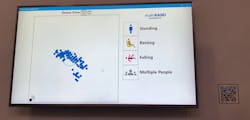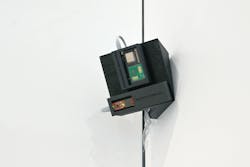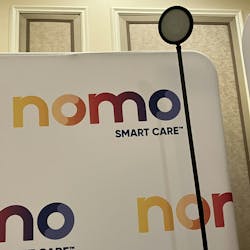This article originally appeared in the February 2025 issue of Security Business magazine. Feel free to share, and please don’t forget to mention Security Business magazine on LinkedIn and @SecBusinessMag on Twitter.
The Skinny:
-
Millimeter Wave Expansion: Once limited to airport security, mmWave technology is now more affordable due to advancements in AI-powered semiconductor chips, driving its adoption in security, healthcare, and automotive applications.
-
Privacy-Focused Health Monitoring: Companies like Asahi Kasei Microdevices and Nomo Smart Care are leveraging mmWave for elderly care and fall detection, offering non-intrusive, camera-free solutions that track motion and vital signs while preserving privacy.
-
Broad Future Applications: mmWave's capabilities extend beyond healthcare, with potential uses in perimeter security, access control, and automotive safety.
Millimeter wave technology has come a long way since it found its way into the security industry via full-body scanners installed in airports and other high-traffic public facilities post-9/11.
While those applications still exist and are flourishing, a significant decrease in the cost of millimeter wave (mmWave) technology development – driven in large part by AI semiconductor chip manufacturers – has paved the way for a rapid increase in potential uses, especially in security and safety applications.
“The cost [of mmWave] is coming down because the market size is growing so much,” explains Gregg Rouse, President of Asahi Kasei Microdevices (AKM), a division of Japanese semiconductor company Asahi Kasei Corp. “It is a faster-growing market than a lot of other technologies. A lot of those technologies used in airports or the military were all discreet, so the design was very complicated, and it was incredibly expensive. Now you can [use mmWave technology using] a single-chip solution with a module that has a four-channel transmitter and a four-channel receiver.”
Thanks to research and development by semiconductor companies like Asahi Kasei, once-cost-prohibitive technologies like mmWave are becoming affordable thanks to improved manufacturing that has condensed the size of components and per-unit costs of adding them to chipsets. Additionally, 5G’s rollout paved the way for a much more widespread use of mmWave – further incentivizing the reduction of costs and introducing a flurry of new competitors into the technology space.
We found two companies at CES showcasing mmWave. And while both companies – AKM and a startup called Nomo Smart Care – demoed it in the elderly care and fall detection space, the go-to-market strategy is vastly different.
Creating the Hardware
AKM showcased the potential of mmWave packaged in a tiny sensor that could be mounted in the corner of a room – much like a traditional PIR sensor – to cover a wide area; in fact, it is conceivable that mmWave could eventually replace a traditional PIR sensor to add presence and fall detection throughout a facility.
“[mmWave] allows for a lot better accuracy of fall detection and movement tracking,” AKM’s Rouse explained during a live demo of the solution, which uses AKM's antenna-in-module (AiM) technology that combines antennas and a 60 GHz mmWave radar transceiver into one unit. “There's more than just fall detection you can do with this. You can use other motion tracking – or how the person is moving in the house – that would allow you to further improve the result of what you can get from a fall detection algorithm. An AI algorithm can track daily patterns and alert to deviations.”
AKM’s technology also captures essential health indicators as anonymous data points, enabling AI systems to enhance care and safety without infringing on personal privacy. In a healthcare monitoring environment and elder-care facilities, having a camera in rooms where people live, or in bathrooms, etc., is often a non-starter. The data produced by mmWave is completely anonymous; in fact, the AKM demo displayed a human presence as a series of colored dots – with a different color representing someone sitting, standing, lying down, or falling.
“The most common fall places are in the bathroom and in the bedroom, which are two places people don't want a camera,” Rouse says. “One of the advantages of millimeter-wave at 60 gigahertz is that it can pass through objects to determine whether or not the object is alive. We can use mmWave to detect breathing – so basically, if someone falls down and they are breathing, we know it is not just a plant. We can tell whether it is a human.”
AKM’s go-to market is targeted at other software/hardware providers interested in incorporating mmWave into its offerings. As Rouse says, AKM is providing the hardware, but “AI software companies can do a lot more with the data than a simple fall detection demo.”
Nomo’s Direct-to-Consumer Model
While AKM is building mmWave-based systems from the inside out, Nomo Smart Care, a Minnesota-based elder care startup launched in 2023, is packaging it with a full line of fall detection and health monitoring solutions and marketing it as “in-home, no-camera safety technology reshaping caregiving by solving a key challenge: How to keep loved ones safe in their home without sacrificing their privacy or independence.”
According to a press release, the Nomo Smart Care system includes a hub, satellites, and tags that work together to monitor daily activity in the home, tracking routines such as ensuring the medicine cabinet or refrigerator is opened, fall detection, and irregularities in daily routines. The data is delivered to caregivers in real-time via an app.
At CES, the company introduced its mmWave solution. “We have millimeter wave in different implementations,” Nomo’s David Baer explained at the company’s booth at the Pepcom showcase. “It can be built right into [a sensor] within the home, or we can embed it in something like a lamp fixture. It can determine orientation, detect falls when they happen, the number of people, and differentiate human from animal.”
But the technology is capable of so much more in the healthcare monitoring environment, according to Nomo CTO Kevin Ray.
“The entire category of millimeter wave allows us to balance two important things – a high fidelity of knowing what's occurring and privacy compliance,” Ray says. “What we are able to report is not only someone’s kinematics – standing, walking, sitting, falling – but the resolution is so high that we can see respiration rate and signs of vitals, which is really unique. There aren't a lot of other technologies that can tell you dad is lying on the couch and he has stopped breathing. “It is an amazing technology, and we expect a whole lot of [Nomo] products to come out based on our core [mmWave].”
Nomo’s mmWave is based on technology from Texas Instruments. “It allows us, in a single chip, to integrate the antennas as well as the processor,” Ray explains. “That gives us a high-resolution image that are point clouds of all the targets in an environment. From the point clouds, then we can either do simple analysis to detect orientation. But then we can actually run those through classifiers, and build (machine learning) models in the cloud to recognize different events that are occurring.”
Ray continues: “What's nice about that is we don’t stream anything out of the house. We don't want to stream video or audio out, and we don't want to rely on cloud computing to analyze what's happening. Instead, we want to do that as edge computing within the house to keep it private. We use the cloud to connect with caregivers, letting them know there might be a problem.”
The Future of Millimeter Wave
Many applications of mmWave – like many technologies on the CES show floor – are being driven to adoption by the automotive market.
“This same 60 GHz technology can be used for child-left-behind applications in cars, driver monitoring, or as for detection to know where the seat belt should be,” Rouse says. “The automotive market drove a lot of development in this, and fall detection is just another use-case for the same technology. As the overall market potential increases, it further brings down the cost.”
Ray also sees a ton of potential. “The guy on our team who built the [circuit board assembly] and designed how it works will be the first to tell you: We are just starting in. This chip is so powerful, and the ability to generate this high-resolution data without actually physically connecting creates an unbelievable future roadmap,” he says. “It's going to be a wild ride.”
This chip is so powerful, and the ability to generate this high-resolution data without actually physically connecting creates an unbelievable future roadmap. It's going to be a wild ride.
- Kevin Ray, CTO and co-founder of Nomo Smart Care
With further development and refinement, it is easy to see the potential for mmWave as the preferred security technology for everything from perimeter security to intrusion detection and access control. “A cable installer or a home security installer can install it easily because it is low-voltage wiring," Ray explains. "A small business or a warehouse can do the same thing: They can put these in every room in the building and have an alarm installer come in, snap them into place, and get rid of those two big expensive cameras.”
About the Author
Paul Rothman
Editor-in-Chief/Security Business
Paul Rothman is Editor-in-Chief of Security Business magazine. Email him your comments and questions at [email protected]. Access the current issue, full archives and apply for a free subscription at www.securitybusinessmag.com.






